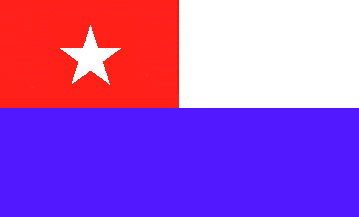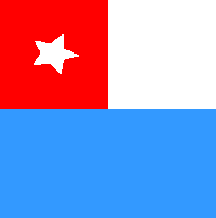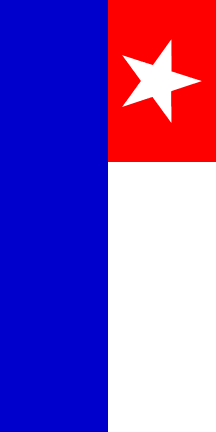
image by Jaume Ollé

Last modified: 2006-11-11 by dov gutterman
Keywords: cuba | cespedes |
Links: FOTW homepage |
search |
disclaimer and copyright |
write us |
mirrors
See also:
The flag was used by Carlos Manuel de Céspedes, known as the
Father of Cuba, in his famous uprising known as the "Grito
de Yara" of October 10, 1868. This uprising initiated the 10
Year War during which this flag was the flag of Cuban
"Independentistas" or pro independence fighters. The 10
Year War ended in 1878 with a truce that allowed Spainish rule
over Cuba to continue.
When Cuba became independent from Spain on May 20, 1902, this
flag was officially designated the flag of the city of his birth:
Bayamo, Oriente, and the flag which Venezuelan-born, Cuban
patriot, Narciso López flew in the city of Cárdenas on May 19,
1850, was officially designated the Cuban national flag. In honor
of Cespedes and the bravery of the residents of Bayamo, who
during the 10 Year War burned the prosperous city to the ground
and moved to the forrest rather than surrender it to the
Spaniards, Bayamo was proclaimed a "National Monument"
and from then on would have its name proceeded by the initials
M.N. for "Monumento Nacional." Since Cuba gained
independence from Spain, the flag of Bayamo is displayed
alongside the Cuban national flag at official ceremonies and
events.
Dr. Eladio José Armesto, 1 April 2002
Apparently, the cuban parliament just changed the country's
constitution in order to make the socialist regime untouchable by
the legislators. This was an information given today on our TV,
and the brief report showed images of the cuban parliament in La
Havana. There where two flags in display, both vertical, and both
attached to the wall behind the honour tribune, where major
officials seat. These flags where on both sides of the Cuban Coat of Arms, which was in the center of the
wall. To the right of the Coat of Arms (viewer's left) there was
the cuban flag, in a vertical variation and to the other side,
there was another flag, practically identical to an eventual
vertical variation of the chilean flag, only with the colours
reversed to match the colours of the national flag. Both flags
seemed to be 2:1, and in both flags I don't know if the star is
rotated of not: the footage was too short for that.
Any ideas? A flag of the parliament, perhaps?
Jorge Candeias, 27 June 2002
I believe that is the Céspedes flag and if I am not mistaken
also serves today as the flag of Céspedes' home town. It
appeared in the background in a movie whose title escapes me
(starring Antonio Banderas and Angelina Jolie), set in
19th-century Cuba. I might add (I thought of this after posting)
that in both the movie and in your image of the Vertical
Flag, the red canton is displayed in the upper right,
contrary to the usual practice.
Al Kirsch, 27 June 2002
Correction: contrary to the usual "American"
practice. Many countries simply rotate their flags when
displaying them vertically, and this is one such case.
Jorge Candeias, 27 June 2002
According to my file (taken from an old Cuban book on Symbols
of the fatherland), this is the flag of Carlos Manuel de
Céspedes dated 1868.
Norman M. Martin, 28 June 2002
According to "National Geographic (may 1949)" and to
"Flaggenbuch 1939" this flag is the Cuban Jack.
Luismi Arias, 28 June 2002
Indeed it is the Cuban Jack
according to the naval flags page, and the Céspedes flag, in the
historical pages, not even a as well. So we have a flag that is
historical, and also used as naval jack, a situation not uncommon
in Latin America. But what o is it doing hanging on the
parliament wall?! Aren't jacks supposed to be flown exclusively
at sea?
The only thought I can come up with is that the display is
supposed to show all the national symbols of the country...
Jorge Candeias, 28 June 2002
Since the event was quite political, using the cespedes flag
was probably meant as a message of continuity and resolves in the
same way as for the americans displaying the current national
flag with either the "betsy ross" or the "don't
tread on me" flags.
Marc Pasquin, 28 June 2002
It is a variation of the Ce'spedes flag, yes. But a question
remains: what is it doing insude the parliament building side by
side with the cuban national flag and Coat of Arms?
Jorge Candeias, 28 June 2002
I don't think it is a "variation". I think it
is intended to be THE Céspedes flag (and not the jack).
The original flag preserved in a Havana museum is square, but
since its construction was quite haphazard, I think the
dimensions and ratio are irrelevant. Cuban political culture
probably explains its presence in the parliament building.
Unlike other socialist states, Castro has steadfastly refused any
personality cult or iconography around living Cubans. Only
dead heros are celebrated: Guevara and Cienfuegos of the
1959 revolution, and those of earlier revolutions. The
incompleteness of these revolutions probably explains why they
are celebvrated as a total continuum. The 1868 revolution
failed, but is remembered as the all-important "first war of
independence". The second war of independence (1898)
was hijacked by the United States. To a lesser extent the
present government admits that the 1959 revolution left them as a
less-than-independent client of the Soviet Union. The fall
of the Soviet Union introduced the "epoca especial" in
Cuba, which the current regime considers the dawn of true
independence. Therefore Cuba celebrates the three wars of
1868, 1898 and 1959 as a totality of equal importance, and the
dead heroes of these wars and their related mythology and
iconography is evident throughout Cuba. (For example, Jose
Marti dominates the revolutionary plaza in Havana and every
school yard in Cuba.) Since the Céspedes flag was the
first independentist flag, it still has a major place of honour.
It is worth noting in this context that when the 1959 revolution
became the new government it did not substitute the red/black
flag of the 26 July Movement for the existing Cuban flag since
the latter was already considered a revolutionary flag.
"Los Simbolos de la nacion cubana" by Enrique Gay-Calbo
(1958, reprinted 1999) has a chapter largely devoted the
Céspedes flag.
Tom F. Mills, 28 June 2002
As an illustration of the points Tom and Marc made, there is
an excerpt from a statement made by five Cuban prisoners held in
the U.S.: "To the people of Cuba: For us five, prisoners of
the empire, it is an honor to have been proclaimed heroes of the
Republic of Cuba by a people that it by its own heroic, in a
National Assembly (Parliament) that represents the traditions of
struggle of our people as it is represented in our national
shield, the Céspedes flag and the lone star flag that preside
over their meeting..." [taken from <www.blythe.org>].
It seems clear from the remark in the above message that Tom and
Marc's interpretations are on target (even if the translation
appears to be garbled in a few non-relevant spots).
An image of Castro addressing Parliament in front of the two
flags and the shield, can be seen at <www.ain.cubaweb.cu>.
Ned Smith, 28 June 2002
Although the photo that
Ned located is small, it isn't as small as it appears on the page
and I could get some more graphical info. My first image of the Vertical Flag made after TV images is accurate,
but not entirely: the red canton isn't square, as I first
thought, but rectangular (roughly 2:3 in dimensions). The star,
however, is as I drew it: non-rotated. The photo, which is the flag on
the wall rotated and enlarged for better viewing: you can see
distinctly two small bulbs in the bottom of
the white star, corresponding to the two lower points.
Jorge Candeias, 28 June 2002
According to <www.nacion.cult.cu>,
the Flag of Yara is displayed alongside the National Flag in the
National Assembly, and has been so for more than a century; note
that the dimensions of this flag is the same as the National Flag
(proportions 1:2, canton square), which is different from the
Naval Jack, which is again different from the original flag, with
its star in an unusual angle.
Miles Li, 21 October 2006

image by Guillermo Aveledo, 6 October 2000
Flag of the Demajagua, named after the name of Carlos Manuel
de Céspedes' ranch, hoisted on October 10th, 1868. This image is
based on <www.autentico.org>
and the book "Banderas Oficiales y Revolucionarias de
Cuba", written by Emilio Roig de Leuschering, and published
in Havana, by the Municipio de la Habana publishing house, in
1950.
Guillermo Aveledo, 6 October 2000

image by Jorge Candeias, 28 June 2002